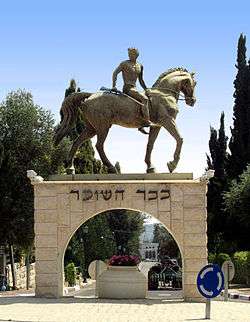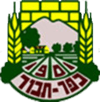Kfar Tavor
Kfar Tavor
| ||
|---|---|---|
|
Watchmen's Square in Kfar Tavor | ||
| ||
 Kfar Tavor | ||
| Coordinates: 32°41′13″N 35°25′15″E / 32.68694°N 35.42083°ECoordinates: 32°41′13″N 35°25′15″E / 32.68694°N 35.42083°E | ||
| Grid position | 189/232 PAL | |
| District | Northern | |
| Founded | 1901 | |
| Government | ||
| • Type | Local council (from 1949) | |
| • Head of Municipality | Yosef Dola | |
| Area | ||
| • Total | 1,231 dunams (1.231 km2 or 304 acres) | |
| Population (2015)[1] | ||
| • Total | 3,796 | |
Kfar Tavor (Hebrew: כְּפַר תַּבוֹר, Arabic: كفر تافور) is a village in the Lower Galilee region of Northern Israel, at the foot of Mount Tabor. Founded in 1901, it was awarded local council status in 1949. In 2015 it had a population of 3,796.
History
Ceramics from the Byzantine era have been found here.[2]
Ottoman era
In the Ottoman era was here a village called Mes'ha.[3] In 1596 the village appeared under the name of "Masha" in the tax registers as part of the nahiya (subdistrict) of Tabariyya in the Sanjak (district) of Safad. It was noted as "hali"(=empty), but a fixed tax-rate of 25% on agricultural product was paid. These products included wheat, barley and cotton; the taxes totalled 3,300 akçe.[4] In 1799 it appeared as Mechi on the map Pierre Jacotin compiled that year.[5]
In 1881, the Palestine Exploration Fund's Survey of Western Palestine described "Meshah" village with a population of 100 Muslims, with houses chiefly of basalt stone, and a few of adobe and stone. The village was situated on an arable plain, without trees. The water supply was from a cistern in the village.[6]
Kfar Tavor was established in 1901 by pioneers of the First Aliya under the auspices of the Jewish Colonization Association.[7] Twenty-eight farmers settled in the area with the assistance of the philanthropist Baron Edmond de Rothschild. The new settlement was originally known as Mes'ha, the name of the nearby Arab village. It was renamed in 1903 at the urging of Zionist leader Menachem Ussishkin who visited the site and was surprised to find it had no Hebrew name.[8] At first, there was some debate over whether to use the term kfar ("village"), which some residents thought would bode badly for future growth. Ussishkin responded that he had visited the German town of Düsseldorf, which had also originated as a Dorf, or village, but was now a full-fledged city. The Rothschild administration determined that the site was ideal for cultivating grapes. The vineyards of Kfar Tavor became a supplier of grapes to the country's wineries.
British Mandate era
In the 1922 census of Palestine conducted by the British Mandate authorities, Mesha (Kufr Tabur) had a population of 274; all Jews.[9]
In 1945 Kfar Tavor had 230 inhabitants, all Jews. Mas-ha was noted as an alternative name.[10][11]
Landmarks
In the Hameyasdim neighborhood, the core of the village, there is a museum and other sites, including the HaShomer house, the first school and teacher's house (now a library) and a synagogue that was built in 1937. Another school, built in 1911, now serves as the Shenkar Tzfira Music Center. The main street of the neighborhood has houses left from the village's early days, as well as parts of the wall that surrounded it.[8]
Notable residents

- Yigal Allon (1918–80), politician, commander of the Palmach, and general in the IDF, was born in Kfar Tavor.
- Itay Segev (born 1995), basketball player
References
- ↑ "List of localities, in Alphabetical order" (PDF). Israel Central Bureau of Statistics. Retrieved 16 October 2016.
- ↑ Dauphin, 1998, p. 730
- ↑ "The place of unction", according to Palmer, 1881, p. 131
- ↑ Hütteroth and Abdulfattah, 1977, p. 187
- ↑ Karmon, 1960, p. 167
- ↑ Conder and Kitchener, 1881, SWP I, p. 361
- ↑ Ben-Porat, Amir (1991). "Immigration, proletarianization, and deproletarianization A case study of the Jewish working class in Palestine, 1882–1914". Theory and Society (20): 244.
- 1 2 http://www.hooha.co.il/place_english.htm
- ↑ Barron, 1923, Table XI, Sub-district of Tiberias, p. 39
- ↑ Department of Statistics, 1945, p. 8
- ↑ Government of Palestine, Department of Statistics. Village Statistics, April, 1945. Quoted in Hadawi, 1970, p. 62
Bibliography
| Wikimedia Commons has media related to Kfar Tavor. |
- Barron, J. B., ed. (1923). Palestine: Report and General Abstracts of the Census of 1922. Government of Palestine.
- Conder, Claude Reignier; Kitchener, H. H. (1881). The Survey of Western Palestine: Memoirs of the Topography, Orography, Hydrography, and Archaeology. 1. London: Committee of the Palestine Exploration Fund.
- Dauphin, Claudine (1998). La Palestine byzantine, Peuplement et Populations. BAR International Series 726 (in French). III : Catalogue. Oxford: Archeopress. ISBN 0-860549-05-4.
- Department of Statistics (1945). Village Statistics, April, 1945. Government of Palestine.
- Karmon, Y. (1960). "An Analysis of Jacotin's Map of Palestine" (PDF). Israel Exploration Journal. 10 (3,4): 155–173; 244–253.
- Hadawi, Sami (1970). Village Statistics of 1945: A Classification of Land and Area ownership in Palestine. Palestine Liberation Organization Research Centre.
- Hütteroth, Wolf-Dieter; Abdulfattah, Kamal (1977). Historical Geography of Palestine, Transjordan and Southern Syria in the Late 16th Century. Erlanger Geographische Arbeiten, Sonderband 5. Erlangen, Germany: Vorstand der Fränkischen Geographischen Gesellschaft. ISBN 3-920405-41-2.
- Palmer, E. H. (1881). The Survey of Western Palestine: Arabic and English Name Lists Collected During the Survey by Lieutenants Conder and Kitchener, R. E. Transliterated and Explained by E.H. Palmer. Committee of the Palestine Exploration Fund.
External links
- Photo of Mes'ha (Kfar Tavor) from 1910
- Survey of Western Palestine, Map 6: IAA, Wikimedia commons

